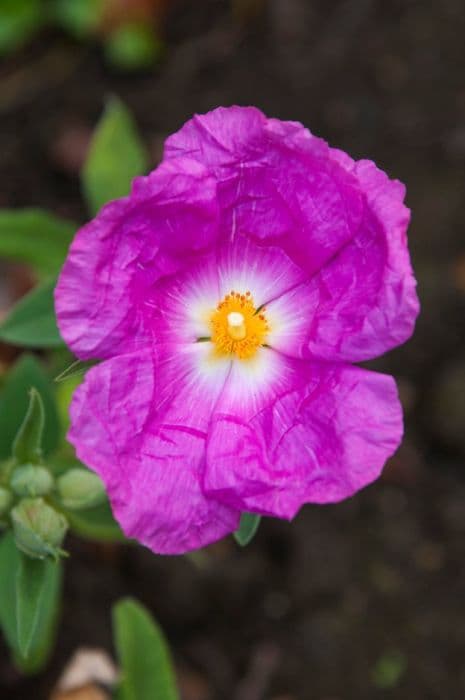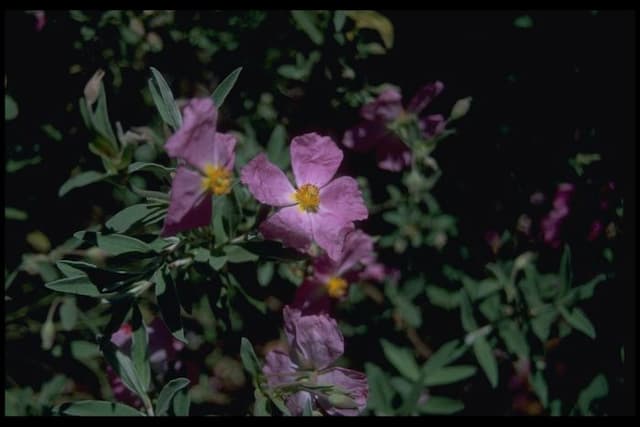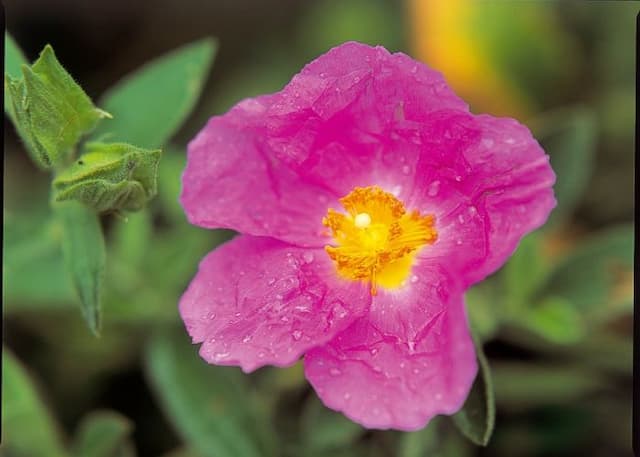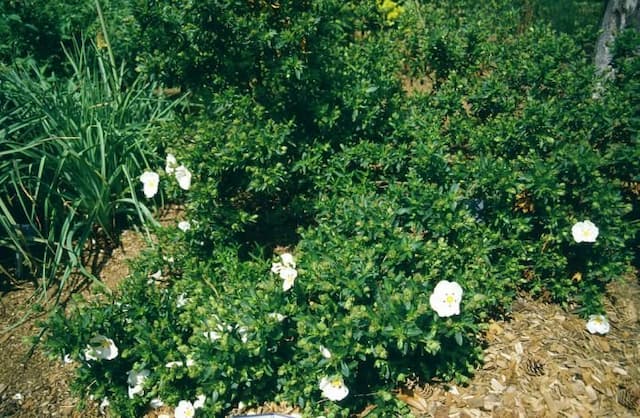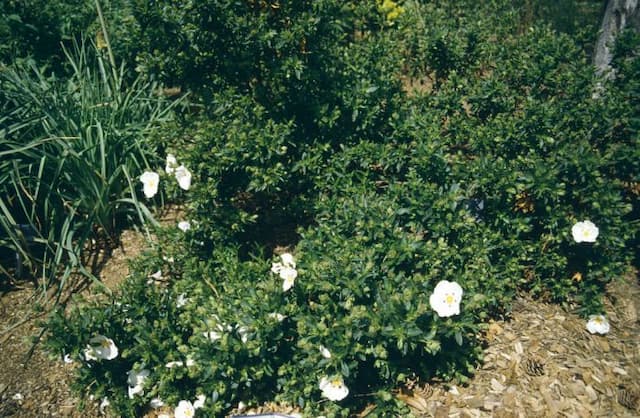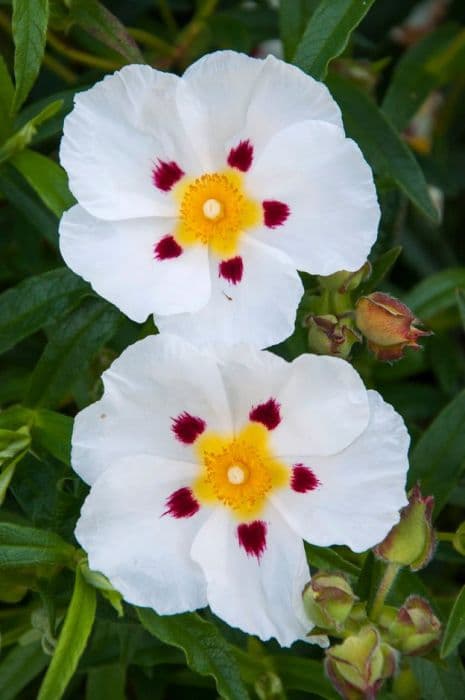Rock rose 'Gordon Cooper' Cistus 'Gordon Cooper'

ABOUT
'Gordon Cooper' is a vigorous spreading evergreen shrub with lance-shaped leaves and white flowers to 5cm across, with a prominent deep maroon blotch at the base of each petal
About this plant
 Names
NamesFamily
Cistaceae
Synonyms
Rock Rose, Sun Rose
Common names
Cistus 'Gordon Cooper'.
 Characteristics
CharacteristicsLife cycle
Perennials
Foliage type
Evergreen
Color of leaves
Green
Flower color
White
Height
3 feet [0.91 meters]
Spread
5 feet [1.52 meters]
Plant type
Shrub
Hardiness zones
8
Native area
Mediterranean
Benefits
 General Benefits
General Benefits- Easy to grow - Cistus 'Gordon Cooper' is known for being a hardy plant that can easily establish itself in a variety of garden settings with minimal care.
- Drought-tolerant - Once established, it is highly resistant to drought, making it ideal for dry climates and water-wise gardening.
- Attracts pollinators - Its flowers are a food source for bees and other pollinating insects, helping to support local ecosystems.
- Fast-growing - This plant is capable of quick growth, filling in garden spaces and providing structure in a short period of time.
- Low maintenance - Cistus 'Gordon Cooper' generally does not require frequent pruning or deadheading, saving time and effort in garden upkeep.
- Evergreen foliage - It retains its leaves throughout the year, providing constant greenery and contributing to the garden's aesthetic even in winter.
- Showy flowers - The plant produces large, attractive flowers that can enhance the visual appeal of any garden space.
- Deer resistant - The plant is not typically favored by deer, reducing the likelihood of damage from browsing animals.
- Soil adaptable - It can grow in a variety of soil types, although it prefers well-drained soils.
- Wind resistant - Its structure and innate hardiness allow it to withstand windy conditions, making it suitable for coastal gardens or exposed sites.
 Medical Properties
Medical PropertiesThis plant is not used for medical purposes.
 Air-purifying Qualities
Air-purifying QualitiesThis plant is not specifically known for air purifying qualities.
 Other Uses
Other Uses- Cistus 'Gordon Cooper', commonly known as rockrose, can be used as a natural dye source for fabrics, yielding various shades depending on the mordant used.
- The sticky resin on rockrose leaves, called labdanum, has been traditionally used in perfumery and aromatherapy for its warm, amber-like fragrance.
- The dense growth habit of rockrose makes it suitable for use as a privacy screen or hedge in landscaping.
- Due to its deep root system, rockrose can help with soil stabilization on slopes and in erosion-prone areas.
- Rockrose's showy flowers provide a valuable nectar source for bees and other pollinators, supporting local ecosystems.
- The plant can be crafted into holiday wreaths and decorations thanks to its evergreen foliage and winter blooming in milder climates.
- Rockrose can be used in xeriscaping, a landscaping method that reduces or eliminates the need for supplemental water from irrigation.
- Its dense and low growth makes it an excellent ground cover, outcompeting weeds and reducing garden maintenance.
- In coastal areas, rockrose can function as a windbreak, helping to protect more delicate plants from strong sea breezes.
- The resin from rockrose can also be used as a fixative in potpourris and incense, extending the life of the other scents.
Interesting Facts
 Feng Shui
Feng ShuiThe Rockrose is not used in Feng Shui practice.
 Zodiac Sign Compitability
Zodiac Sign CompitabilityThe Rockrose is not used in astrology practice.
 Plant Symbolism
Plant Symbolism- Survival: Cistus, commonly known as Rockrose, often grows in tough, challenging conditions, symbolizing the ability to thrive despite adversity.
- Beauty: The delicate flowers of the Rockrose represent beauty emerging from hardship, as they often bloom in rocky, less fertile soil.
- Healing: The Rockrose has been used in traditional medicine, and so it has become a symbol of healing and recovery.
- Resilience: With its capacity to regenerate after fire, the Rockrose stands for resilience and the power to recover from damage or destruction.
- Ephemeral Nature of Life: The flowers of the Rockrose typically last only for a day, symbolizing the temporary nature of existence and the preciousness of the present moment.
 Water
WaterThe Rock Rose (Cistus 'Gordon Cooper') requires moderate watering. During its growing season in spring and summer, it should be watered thoroughly once every week with approximately 1-2 gallons of water, depending on the size of the plant and the environmental conditions. Ensure the top inch of soil dries out before the next watering to prevent overwatering. In the fall and winter months, reduce watering to every other week as the plant enters a dormant phase.
 Light
LightThe Rock Rose thrives in full sunlight, so it's best positioned in a spot where it can receive at least six hours of direct sunlight daily. This plant can handle partial shade, but it will flower best with ample sun. Avoid deeply shaded areas, as this can impede its growth and flowering capacity.
 Temperature
TemperatureThe Rock Rose is hardy and can tolerate a wide range of temperatures. It can survive minimum temperatures down to about 20°F but thrives in areas where the average temperature is between 60°F and 75°F. To ensure optimal growth, try to avoid exposing the plant to temperatures below 20°F or above 100°F.
 Pruning
PruningThe Rock Rose should be pruned to maintain its shape and encourage bushier growth. Prune immediately after the blooming period ends, typically in mid-summer. Remove any dead or overgrown branches, and cut back up to one-third of the plant to keep it robust. Pruning annually will also help in preventing the center of the bush from becoming woody and unattractive.
 Cleaning
CleaningAs needed
 Soil
SoilRockrose (Cistus 'Gordon Cooper') thrives in well-draining soil with a mix of sand or gravel and compost or peat to retain some moisture. The soil pH should be slightly acidic to neutral, ranging from 6.0 to 7.5 for optimal growth.
 Repotting
RepottingRockrose plants, including Cistus 'Gordon Cooper', do not require frequent repotting and can often be left undisturbed for several years. They should only be repotted if they have outgrown their current pot or if the soil has degraded significantly, which may happen every 3 to 5 years.
 Humidity & Misting
Humidity & MistingRockrose (Cistus 'Gordon Cooper') is adaptable to a wide range of humidity levels but prefers a drier climate. It does not require high humidity and can flourish in the average humidity found in most outdoor environments.
 Suitable locations
Suitable locationsIndoor
Provide bright light and good air circulation.
Outdoor
Plant in sunny spot with well-draining soil.
Hardiness zone
8-11 USDA
 Life cycle
Life cycleThe Cistus 'Gordon Cooper', commonly known as Rockrose, begins its life cycle with seed germination, which is often prompted by exposure to fire or heat in its natural environment. After germination, the seedling goes through a period of vegetative growth, developing a sturdy root system and foliage. As the plant matures, it enters a flowering stage, typically in late spring to early summer, producing showy, short-lived flowers that attract pollinators. Following pollination, Rockrose sets seeds, which are released as the fruits dry and open. The plant is a perennial shrub, so this cycle of flowering and seed setting can happen annually for several years. Rockrose plants may eventually senesce and die, completing their life cycle, but they often leave behind seeds that can persist in the soil seed bank for future germination.
 Propogation
PropogationPropogation time
Spring-Early Summer
Cistus 'Gordon Cooper', commonly referred to as Rockrose, is most effectively propagated through semi-hardwood cuttings. This method is commonly employed during the late summer. To do this, select a healthy, non-flowering shoot and make a cutting approximately 4 to 6 inches (10 to 15 centimeters) long. Remove the leaves from the lower half of the cutting and dip the cut end into a rooting hormone. Stick the cutting into a pot filled with a mix of equal parts perlite and peat moss, ensuring that the leafless part is buried. Water the cutting and cover it with a plastic bag or place it in a propagator to maintain high humidity. The cutting should root within a few weeks, after which it can be gradually acclimatized to less humid conditions before being transplanted into the garden.
